You know, I tried. I really tried, but there just are not enough hours in the day. You can all take down David Colman’s John Currin & Rachel Feinstein Style section article yourselves. Lord knows everything but the headline–“Their Own Best Creations,” which at least gives a nod to the existence of artifice, spin, image management, the subjective construction of the self–is ripe for the kicking.
I will say that it’s the conveniently swattable straw men that bugged me the most. The specious [or is it?!] notion that “the art world” somehow punishes those artists who aspire to–or even approach–their collectors’ lifestyles. When, in fact, “the art world,” such as it is, is all but obsessed with art’s wave/particle-like duality, its near-magical power to transform culture into capital and vice versa.
The art world has been laboring mightily for decades to accommodate and cater to the needs, desires, lifestyles, and politics of wealth-flaunters, hyper-capitalists, and consumptionists of all kinds, and it pisses me off to see all that hard work go unrecognized by the Style section, of all sections!
The idea that Currin and Feinstein’s conservative political views somehow transgress anything but the feeblest cliche of liberal “art world” orthodoxies. I guess it’s the notion of “an” “art world” that’s so easily thwarted by John & Rachel’s unabashed fabulousness that really gets me.
Such an art world is a fairy tale. There are also more art worlds, and a far greater range of political views within them, than the Style section cares to acknowledge. I can think of a dozen conservatives–even some card-carrying neo-cons–who are prominent, active participants in New York City’s art scenes: artists, dealers, and curators, too, not just collectors or museum people. This heterogeneity is who “we” are, and to pretend otherwise, or to ignore these differences is willful or naive, or both.
Or maybe it’s that political differences in “the art world” have long been tolerated, negotiated, or if need be, consciously set aside or even suppressed in the interests of achieving an art-related goal. And really, are there any political chasms that can’t be bridged by Blanchette Rockefeller’s noble response to questions of whether his years as an enthusiastic Fascist activist might preclude Philip Johnson’s election as a MoMA trustee: “Every young man,” she reportedly said, “should be allowed to make one very large mistake.” I’m sure it works, try it at home!
As for Rachel’s work, and her career, and the inevitable comparison to her husband’s, how can it not be eclipsed? Is it apparently impossible to say that? But what is Rachel to do? Not show? Not make? Show under a pseudonym? Is it impossible to wonder if Rachel’s career differs from John’s because of her medium? Or her content? Or her concept? Or her gender? Was it “being that glamorous” that caused Feinstein to “take [her] eye off the ball” over the last few years, Jerry? Might having and raising three kids play a part? Maybe what Rachel’s career is really missing is a good wife.
Animal, Vegetable or Minimalism?
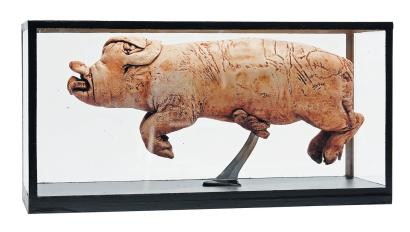
Have we considered Damien Hirst’s vitrine sculptures from the Wunderkammer perspective? Because the giant grab-bag auction at Pierre Berge & Associes in Brussels is stuffed [heh] with disturbing taxidermy, eerie medical/scientific specimens, and elaborate butterfly displays. Yes, that is a butterfly skull under glass. If you’re playing any Hirstian drinking games, you are now passed out on the floor.
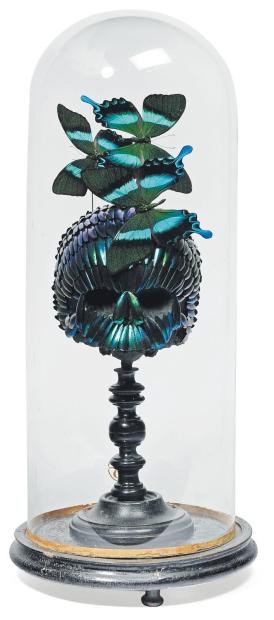
Or have we considered Olafur Eliasson’s art to be inhabiting a similar historical aesthetic trajectory?

Because seriously, put something in a bell jar, or on a tiny little display stand, and it gets immediately objectified and pretty damn near artified.

If not, then hop to it, Art History. Because right now, I’m too busy planning my show of found conceptualism and ur-Post-Minimalism:
Lot 451: a suite of 9 framed marble samples [est. EUR1300-1500]
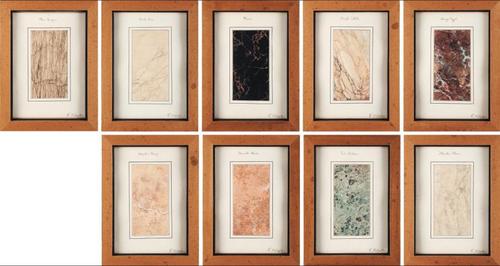
Lot 562: a cube-shaped Oryx-skin pouf [est. EUR 300-450]
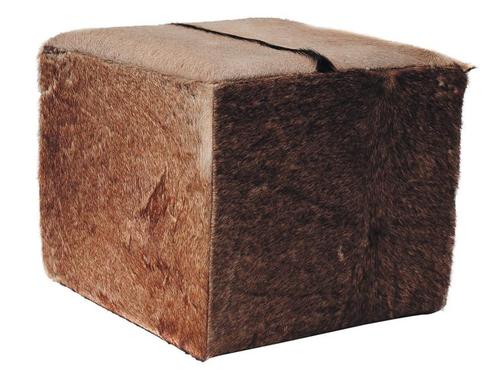
I guess it’s really a pair: Lot 563: a cube-shaped boar-hide pouf [est. 300-450]
Lot 561: a large monochrome grid made of white wolf skin [est. EUR3000-5000]
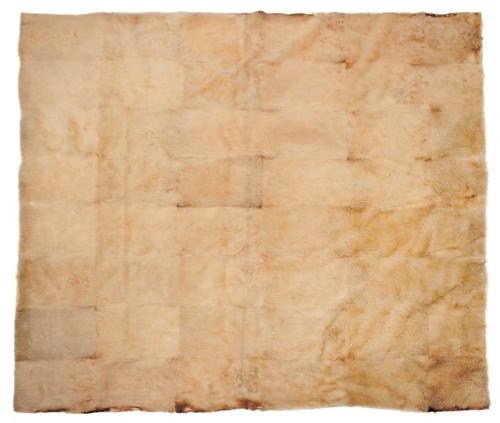
I guess it’s really a diptych: Lot 823: a large monochrome grid made of pink flamingo feathers [est. EUR 1500-2000]
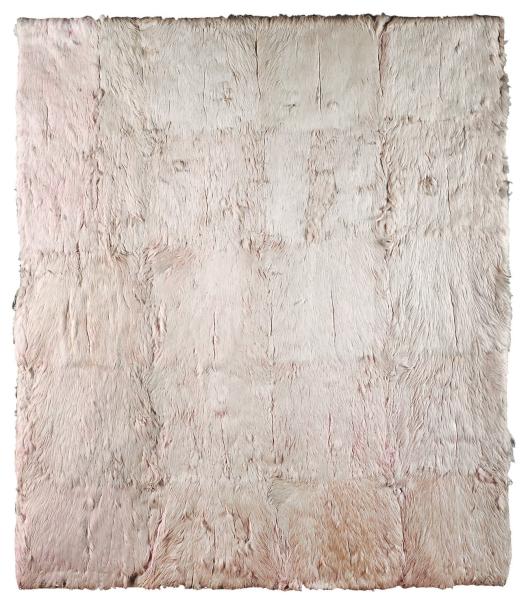
And a couple for the back room:
This could be bigger: Lot 504: a sphere [23cm dia.] of polished thuya root burl [est. EUR 150-200]
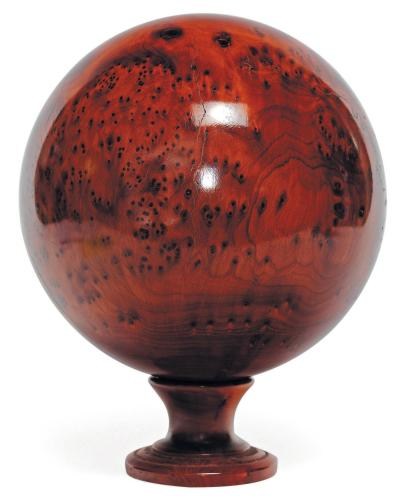
And this could be a bit less Madison Avenue, but still: Lot 576: a plaque of caravan salt from Mali [est. EUR 1200-1500] [ref. flickr]
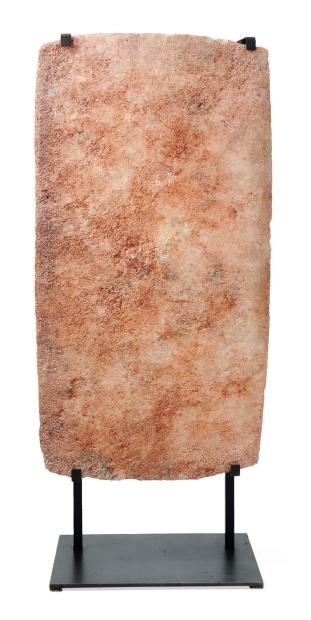
The Second Meeting With The First Meeting Of The Erik Satie Society
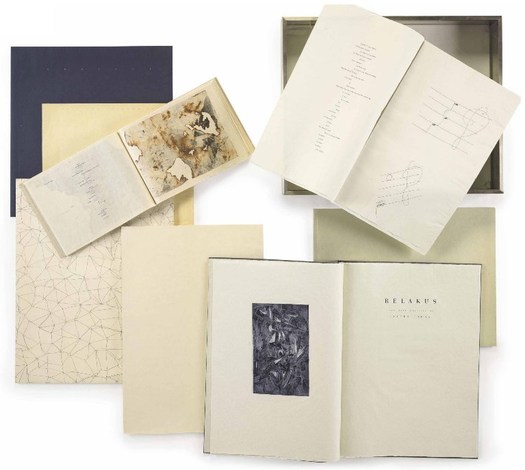
I totally remember seeing John Cage’s The First Meeting of the Erik Satie Society in the summer of 1994. An unbound version was on view at the Fuller Building on 57th Street. Susan Sheehan Gallery. It was on during Cage’s phenomenal retrospective/exhibition/performance, Rolywholyover: A Circus, at the Guggenheim SoHo. [I followed that show around the country like a Phish head, from MoCA, to the Menil, the Guggenheim, to the Philadelphia Museum. The PMA show coincided with my graduation from business school, and I had a couple of weeks where I was able to go every day, and watch the museum’s art handlers perform their I Ching-generated list of reinstallations. A formative experience, one of the absolutely greatest museum exhibitions ever, and probably the greatest catalogue I own. Reproductions of works, poems, and texts are packed loosely in a mirrored aluminum box. It’s a good segue to the Satie Society, and ‘m going to go pull it out right after I post this.]
Anyway. The Merce Cunningham Dance Company just sold a copy of The First Meeting of the Erik Satie Society at Christie’s last week, and I’m a little surprised at how vague the description is. Apparently, Cage’s box set of artist books, drawings and prints was supposed to be an edition of 18, or 9, but then the edition of 9 is described as unrealized, plus an “unbound” edition of 6… Sounds a bit of a mess.
The gist of the piece is that in 1992 Cage invited artists to a birthday party for the French composer who influenced him so profoundly, and the gifts are the artworks, which Cage combined with his own Satie-themed mesostic/acrostics based on writings he admired, too. It’s basically an exercise of homage, inspiration, collaboration, and transformation. Folks like Johns, Rauschenberg, Sol Lewitt and Robert Ryman contributed works, and Cage used texts from the likes of Joyce, Duchamp, Thoreau and McLuhan. The whole thing came in a steel-framed, broken-glass valise, a reference to Duchamp’s famously cracked Large Glass.
I’m going to guess that the version I saw was unbound, because the elements were mounted between freestanding glass panels around the gallery. So there’s one. How there could be ambiguity about work produced by this constellation of major artists just a few years ago–holy crap, almost 20 years ago–is a mystery to me.
Sale 2441, Lot 177: The First Meeting of the Erik Satie Society, by John Cage, est. $90-120,000, sold for $116,000 [christies.com]
Holy crap, $500? Rolywholyover: A Circus on Amazon [amazon]
Previously: Richter’s 4900 Colours and Cage’s Rolywholyover via sippey
I Am An American
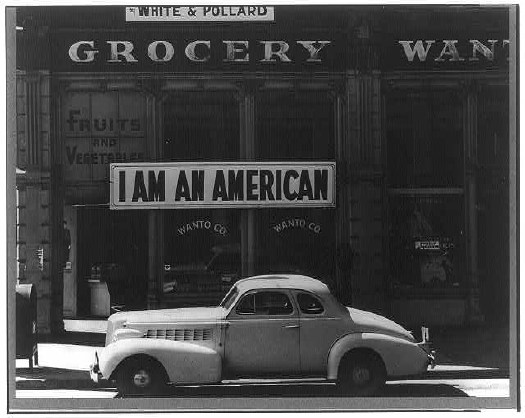
I’ve written and been inspired by Ansel Adams’ WWII Japanese-American internment camp photos for years, but inexplicably, I haven’t looked closely at Dorothea Lange’s. Paul has some intriguing examples at Eyeteeth. He also notes that Lange was actually covering the internment process for the War Relocation Authority, which quickly became as complicated as you might imagine. According to the Library of Congress, the US government immediately censored many of Lange’s photos, which tended to highlight the patriotism of the Americans being imprisoned without cause or charge. They weren’t widely seen or known until 1972, when the Whitney organized an exhibition about the internment titled Executive Order 9066.
The caption on this photo, taken in San Francisco in March 1942, when the store was being confiscated and its owner jailed, says the UC graduate nisei had installed the banner outside on Dec. 8, 1941. So on the bright side, in those four heated, panicked months, no one tore it down.
Day of Remembrance – Dorothea Lange’s Japanese Internment Photos [eyeteeth]
Dorothea Lange: Women Come To The Front [loc.gov]
FunnyorDie
Looks like I picked the wrong week to not start that awkward Twitstream juxtaposition tumblr.

Mormon Missionary And Companion, For Sale, By Jim Shaw
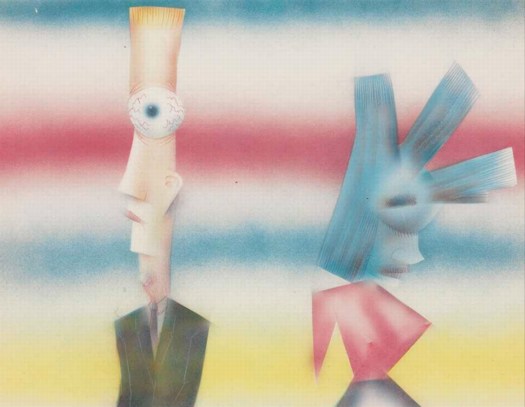
I don’t know how this slipped by me, but now it’s going up for sale tomorrow at Christie’s: a very early Jim Shaw pencil & airbrush drawing from 1981 with the obvious-now-that-you-mention-it title, Mormon Missionary and Prostitute Making Each Other Feel Guilty.
In 1981, Shaw wasn’t even really showing his art yet–the earliest group show in his current, abridged bio wasn’t until 1986. And he was years away from the unveiling of O-ism, his homebrewed, Life of Brian-style, parallel universe version of Mormonism, which he showed at the Swiss Institute and Metro Pictures in 2002. [O, and there was The Donner Party his awesome O-ist reimagining of Judy Chicago’s feminist masterpiece, The Dinner Party, which was at PS1 in 2007.]
Anyway, Shaw was still busy in 1981; Ed Ruscha helped him publish Life And Death, an artist book compilation of airbrush drawings that do look a bit like this Mormon Missionary here. Perhaps they are related.
Lot 30: Jim Shaw, Mormon Missionary and Prostitute Making Each Other Feel Guilty, est. $3000-5000 [christies.com]
From The Mixed Up Files Of Basically Everyone
What’s that, dear? Oh, nothing, just some legendary but unknown drafts for the first film adaptation of Ian Fleming’s Casino Royale, by veteran Hollywood screenwriter Benjamin Hecht.
After reading various references to the early 60s script, Jeremy Duns decided to go looking for it, and whaddyaknow, there it was, sitting in Hecht’s archive, which is at the Newberry Library in Chicago. Apparently, in the intervening decades, no one had ever bothered to actually look for it:
[T]hese drafts are a master-class in thriller-writing, from the man who arguably perfected the form with Notorious. Hecht made vice central to the plot, with Le Chiffre actively controlling a network of brothels and beautiful women who he is using to blackmail powerful people around the world. Just as the theme of Fleming’s Goldfinger is avarice and power, the theme of Hecht’s Casino Royale is sex and sin. It’s an idea that seems obvious in hindsight, and Hecht used it both to raise the stakes of Fleming’s plot and to deepen the story’s emotional resonance.
It’s exactly the kind of mind-boggling, serendipitous archive find that keeps me going on this Johns Flag hunt, even when the more skeptical part of me is saying, “Seriously, how could Jasper Johns’ first flag painting have been stolen, and missing, and then resurface in his own dealer’s office, and then disappear again, and no one knows where it is or even what actually happened to it?” But the more I dig and ask around, the more I find that, though plenty of people gossiped or speculated, almost no one has ever actually searched for it.
UPDATE/CLARIFICATION/APOLOGY/&C. Ha, ha, I guess if I think about it, yeah, my meant-to-be-exciting-thrill-of-discovery-in-uncharted-archives anecdote below could make actual archive professionals cringe. And I guess I didn’t think of that. OR mean it as any kind of criticism of the way the AAA works, just the opposite, in fact.
Fortunately, Barbara Aikens, the Chief of Collections Processing at the Smithsonian’s Archives of American Art took the time to correct some inaccuracies and clarify some of the wrong implications in my account. Which, I didn’t really– I mean, it was really meant to be kind of an amusing offhand story, not a transcript, which– Anyway. My bad.
A few trips ago, while researching at the Archives of American Art, I opened a white cardboard box, indistinguishable from all the others on the outside. But instead of the neatly labeled, acid-free folders, I faced a mishmash of giant envelopes, ragged edges, and old, manila folders. And a rubber banded brick of old AmEx bills. And some matchbooks. What a mess. It was more time capsule than archive.
In the middle of a sheaf of clippings and tear sheets, interviews and reviews and feature articles about Robert Rauschenberg, I came across an odd little card. No, it’s a transparency showing an Apollo alnding capsule. No, there’s three. Blue, magenta, cyan, waitaminnit, this is taped together by hand. It’s an object, maybe even a work, made of layered transparent sheets, similar to Rauschenberg’s editions made from multiple sheets of plexiglass. Shades (1964) is one; I have a similar set of plexi discs somewhere from 1970-1, in a boxed set of multiples titled, Artists and Photographs. Here you go: Revolver.
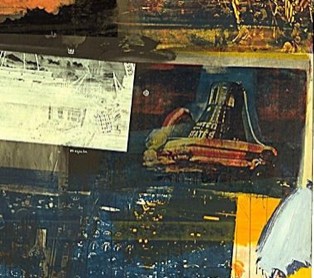
The other day, i recognized that space capsule image as the one in the Hirshhorn’s big Rauschenberg screen/painting, Whale, which is also from 1964. Maybe Bob sent that little objet home after a studio visit or something. But should it really be in here, in the archives, hanging out with greasy-fingered riff-raff like me? Maybe I should say something.
A couple of folders later, I carefully extract a large, tattered, manila envelope with something about a group show or benefit scribbled on the outside. The first thing I pull out is a signed Jim Dine drawing. Then another. The next one is an Oldenburg. I pull out a piece of black paper, which turns out to be a chalk drawing. A little dust gets on my hands. At which point–I mean, fingerprints, right? I’m totally busted–I call the attendant over with a hearty, “Uh, did you know there’s a bunch of original art in here?”
No, she did not, but yes, that happens, because, in fact, budget, priorities, low demand, &c., &c, some of this collection’s boxes had not been processed yet. I was probably the first person to even look through this box since it had come in over 25 years earlier. She gave me a stack of acid-free paper to slip in between the various drawings, and I decided that, though it looked like a blast, the stuff in the packet was obviously not related to my research–at the very least, if Johns’ Flag had been stuffed inside, I would’ve seen it–so I put it all carefully away.
I guess I’m just saying, there’s stuff out there. And no one’s been looking for it, so get cracking.
UPDATE I thought I was being helpful by not identifying the collection I was using here, but of course, Barbara knew right away what it was: the Alan Solomon Archives. The Solomon material had come into the AAA in waves, and the unprocessed box had actually entered the Archive in 2007, not, as I misunderstood, 25+years ago.
The presence of art, drawings, sketches, etc., while not a collecting goal of the Archive, is also not unheard of, and such material typically remains in accessible within the collection, where it is to be handled with care.
Barbara points out that while I made it sound like there I worked through a stack of acid-free paper, in fact, I only inserted three sheets between a couple of drawings. This is true. I was given a stack, but after replacing the works I’d taken out, I figured I’d leave the rest of the handling to the professionals, and so I closed up the box.
On the point of processing, I can’t do better than Barbara’s statement:
On average, we process and preserve about 500-700 linear feet per year; this includes writing full and detailed electronic finding aids that are available on our website. In addition, we are the only archival repository in this country that has a successful ongoing digitization initiative to digitize entire archival collections, rather than just selected highlights from collections. To date, we have digitized well over 100 collections, totaling nearly 1.000 linear feet and resulting in 1.5 million digital files. Archival repositories from across the country regularly consult with us on our large scale digitization methodologies, work flows, and infrastructure.
I would hate to think that users will think less of our major efforts here at AAA to increase access to our rich resources, or, worse, think that we do not care about the stewardship of collections. It is one of our ongoing mission goals and we devote considerable staff resources to our processing work. However, the work is never done to be sure.
And thank you for it. And for the clarifications. Carry on.
Casino Royale: discovering the lost script [telegraph.co.uk via daringfireball]
Gnome
Is there a tumblr for awkward Twitterstream juxtapositions? Because there oughta be.

Live From The Gramery Hotel
Warm nostalgia apparently equals d-bag public access video + time.
Reading Andrew’s report from the Dependent Art Fair, I kept flashing back to the Gramercy, and all the art in the bathrooms, and on the beds, and the insanely crowded hallways.
And whaddya know, there’s a link to a 1995 Gallery Beat episode from “the Gramery Hotel,” where those asshats wandered in on work by unknown artists like Mark Dion, and Tracy Emin, who was not quite protected by the utterly baffled Jay Jopling.
I’d totally forgotten how much I hated that show. And now I’ll probably end up watching the entire archive.
Classic Gallery Beat TV [gallerybeat.net via 16miles.com]
19th Century Photo Murals
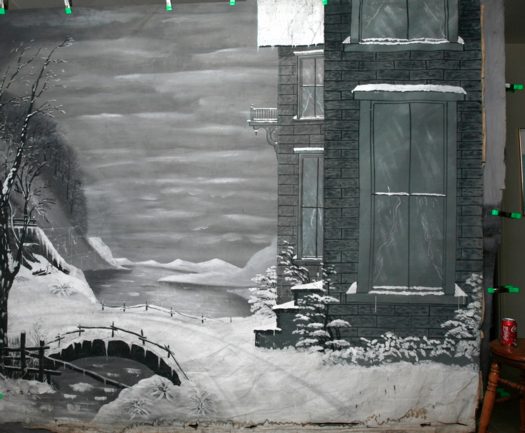
Holy smokes. Of course you know that blogger/collector/scholar Jim Linderman published The Painted Backdrop: Behind the Sitter in American Tintype Photography 1860-1920. Which would make him the go-to guy for anyone with some actual, original, extraordinarily rare, painted 19th century photographer’s studio backdrops to sell.
Jim’s correspondent, in fact, has two. And they look awesome.
I love that they’re painted in black and white. Just like the 19th century itself.
Pair of original 19th century painted photography studio backdrops (for sale) [dull tool dim bulb]
Related: Frederic Remington’s black & white paintings-for-engraving
Stainless Steel Brillo
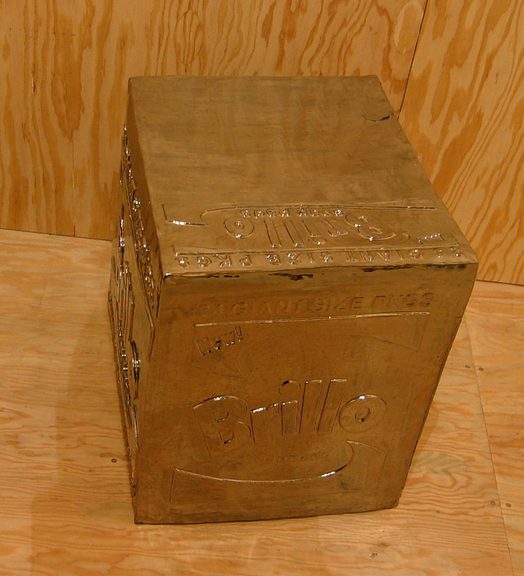
So awesome. Is there nothing that can’t be made better by Rirkrit chroming the hell out of it?
Fear Eats The Soul, Rirkrit Tiravanija, through April 16 at Gavin Brown’s Enterprise [gavinbrown.biz]
Awesome photo of chrome stainless steel Brillo Box and wok, one of many by Andrew Russeth [16miles.com]
Previously: Enzo Mari X Rirkrit Tiravanija
Extensive Brillo Box coverage on greg.org
Ab Eo Scientia A Quo Googleus
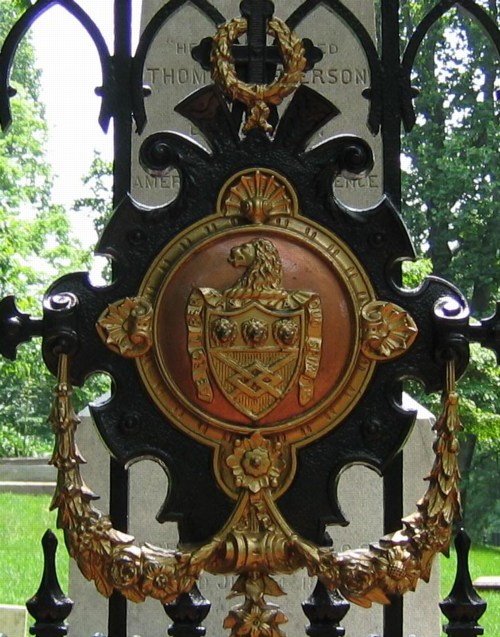
We went to Monticello this weekend–Jefferson was a complicated guy, brilliant, thanks for the Declaration etc, etc., but wow, high maintenance–and came away with a question about the Latin motto in the Jefferson coat of arms, which adorns the gate of the family cemetery where Jefferson and his white lineal descendants are buried.
Though we got the gist of it, the motto, “Ab eo libertas a quo spiritus,” had enough prepositions in it to make it hard to parse. But as we walked down the hill, trying to figure out “eo,” we realized we probably couldn’t. All we could do is look it up, and then we’d know.
That’s the binary situation the net has put us in: we either know something now, or we know it the instant after we look it up. There’s no figuring it out, no hints, just the answer.
Of course, this isn’t true for everything, or even most things–Google’s not just cold telling me where Jasper Johns’ Flag is, that’s for sure–but it’s true for enough things.
And that kind of bums me out a bit.
As for the motto, it does turn out to be a prepositional mess, which Jefferson may have added himself: “The spirit (comes) from he from whom Liberty comes,” or “Liberty comes from he who gives life.”
‘200 Inch Photograph’
Yeah, there’s photomurals, but anyone who’s spent some time poking around greg.org might have found my even longer-lasting photo obsession: the Palomar Observatory Sky Survey [see background and making of info here and here.] The idea is to take he 1,870 pairs of photos that resulted from this ambitious, 9-year project to systematically document the universe, into the art context. Where it had not, to my knowledge, ever been. [Thomas Ruff comes the closest, obviously.]
And so one would understand the excitement at finding this entry–right after Moholy Nagy and Wright Morris, and above Muybridge and Nadar–in the checklist [pdf] for the 1964 inaugural show in the Edward Steichen Photography Center, MoMA’s first dedicated photography galleries:

Mount Wilson and Palomar Observatories
Nebulosity in Monoceros. Situated in south outer region of NGC 2264.
Photographed in red light. 200-inch photograph. December 7, 1958.
Gift of Mount Wilson and Palomar Observatories.
Dude, not only was the Palomar Sky Survey IN an art context; it launched the art context. Dude, with a 200-inch photograph, it owned the art context.
So what did this look like? It must have been spectacular. But I can’t find any installation photos, or any reproduction of the work, or any writeups at all for what had to have been the biggest of the 239 photos on view in that first show, bigger, even, than Lennart Olson’s mural.
No problem, I can find the image from the artist’s [sic] side. Though it has been superseded by several far more advanced surveys, imagery from the 1950s-era POSS-1 is still available in the Space Telescope Science Institute’s Digitized Sky Survey. Here’s the red plate showing nebulosity in the constellation Monoceros on the south outer region of NGC 2264:
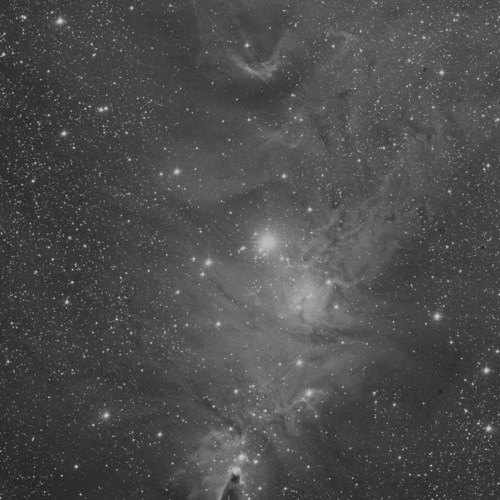
That’s the Cone Nebula down there at the bottom, just on the edge of the plate. Now imagine this photo printed nearly 17 feet tall, striking visitors to the newly reopened Modern with awe as they see how far photography has come.
And you’d have to imagine it, because it didn’t happen. There wasn’t a 17-foot tall photo gallery in the Museum in 1964. In fact, I’d wonder if the ceilings in the then-new Philip Johnson annex were even 16 feet.
Also, it turns out that the POSS-1 image of NGC 2264 was made on Nov. 30, 1951, not Dec. 7, 1958. So the 200-inch photograph does not refer to the print size. It is likely a reference to the telescope that took it, Palomar’s Hale Telescope, which was the largest in the world from 1948 to 1993. It was conceived by George Ellery Hale, who secured $6 million for the project in 1928 from the Rockefeller Foundation.
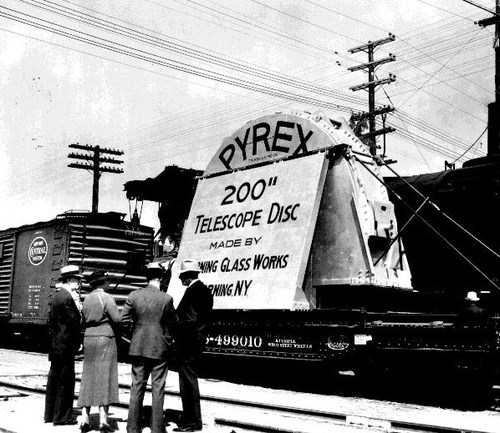
Corning cast the 200-inch mirror from Pyrex in 1934-36, and it was transported across the country by train to Pasadena where, after eleven years of polishing and shaping, the 40-ton mirror was hauled to the top of Mount Palomar and installed in the 1000-ton, Pantheon-sized rotating observatory. Edwin Hubble took the first photograph with the 200-inch telescope in January 1949.
I still haven’t found the details of the photo MoMA exhibited, but the mirror story makes up for it a little. And I thought artists were crazy.
Oh, That’s Right, Philip Johnson Was A Nazi
So I’m searching through the New York Times archive, trying different combinations of keywords to find references to photomurals at the Museum of Modern Art, and I find this intriguing 1934 headline:
TWO FORSAKE ART TO FOUND A PARTY; Museum Modernists Prepare to Go to Louisiana at Once to Study Huey Long’s Ways. GRAY SHIRT THEIR SYMBOL Young Harvard Graduates Think Politics Needs More ‘Emotion’ and Less ‘Intellectualism.’
But the Times’ archives purchasing has been acting up for a few months [it’s not just me, right?], and my 10-pack of articles has been stuck at five since October, so I can’t click through to see who these Museum Modernists are.
And a couple of weeks ago, I could have searched the rest of the internet and not found the answer, but now that Google has added the complete run of Spy Magazine, a search for “Museum Modernists” and “Huey Long” turns up one result: the devastating 1988 Spy article by Michael Sorkin detailing the fascist and Nazi activities of the young Philip Johnson.
I mean, holy crap. Gray Shirt Their Symbol barely scratches the surface. Johnson’s fellow modernist was Alan Blackburn, the Museum’s executive director. As MoMA’s archive puts it, “Both Blackburn and Philip Johnson resigned from the Museum in December of 1934 to pursue outside interests.”
Those interests ranged from donating large sums of money to and founding a youth wing for raging anti-semitic demagogues such as William Lemke and Father Coughlin to spying for the Nazis during the invasion of Poland.
Where was Philip? Spy, Oct. 1988 [google books]
Here’s an image of the Times article and photo. Amazingly vague. [uncommonplace book]
Lennart Olson, Photomuralist

In other seemingly obscure art historical news from 53rd Street: while Googling around on Compo Photocolor, I found this mention in a 1964 press release [pdf] from The Modern, which turns out to be a checklist for the newly remodeled and reopened museum’s first dedicated photography galleries, The Edward Steichen Photography Center:
OLSON, Lennart. (TIO FOTOGRAFER). Swedish, born 1925
139. The Tjorn Bridges, near Sternungsund, Sweden. November, 1960. Conceived as a mural; here executed for the first time. Photomural by Compo- Photocolor. Courtesy of the Photographer.
So just like the first exhibition in MoMA’s original 53rd Street building 32 years earlier, the first show in the new building includes photos specifically conceived as a photomural.
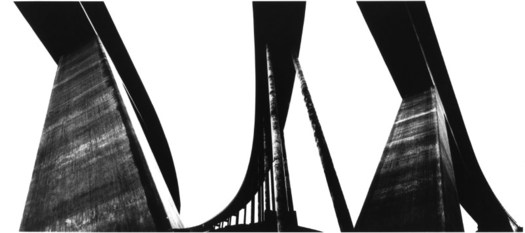
[via]
Olson was a well-known Swedish photographer, though from this 2010 bio for him, his MoMA exposure was the source for much of his hometown fame. And unfortunately, the namechecking is hardly mutual. The only mentions of Lennart Olson on MoMA’s website are from the period press releases.
Steichen included Olson’s work in a 1953 survey of Postwar European photography [pdf]; in 1960, Steichen ends the department’s announcement of new acquisitions [pdf] with this: “Of particular interest is an 8-foot wide photographic panel, “Project for a Mural,” (1960) by Lennart Olson.” Which sounds related to the work that debuted in 1964.
In 1960, Olson was also included in an exhibition titled, “The Sense of Abstraction,” [press release pdf], which was organized by Grace Mayer and Kathleen Haven, who had put out a call for hundreds of photography portfolios. [It’s interesting to read that as a corollary to “straight” photography, abstraction meant producing “works whose sole function is to delight–or affront–the eye.”]
Anyway, Olson’s “monumental architectural studies” opened the show; the Museum described them as “abstract through individualistic interpretation of design.”
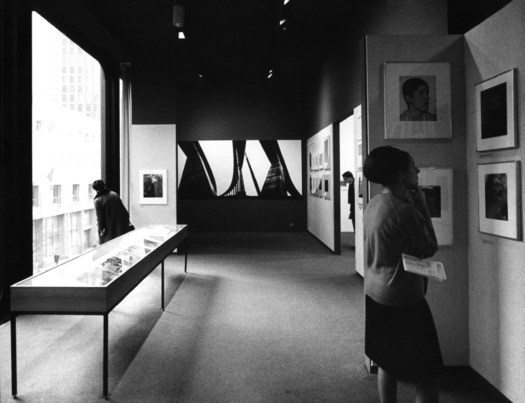
[via]
I can’t find images of the 1960 study, but here is an installation shot of the 1964 mural itself. At first and second glance, the scale and form remind me of Franz Kline, who arrived at his signature large-format abstractions by enlarging small drawings projected onto the wall.
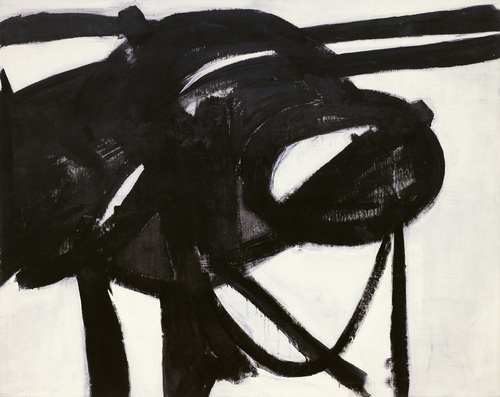
Chief, 1950, acquired by MoMA in 1952
The prominence MoMA gave to Olson’s large, abstract photomural seems to have been confined to the end of the Steichen era, aka the early 1960s. I don’t have any way yet to figure out whether this resonance between Ab Ex painting and large-format photography was conscious or coincidental, but it sure seems convenient.
Talking with artist John Powers today about this speculative painting vs photography dialogue/contest, he suggested looking, not at the artists themselves, but at their mediators: the curators and the museum. It’s easy to imagine curators sharing an attraction to the powerful scale and immersive gallery experience of large, trophy-sized artworks, just as it’s easy to imagine the ambitious size appealing to painters and photographers alike.
On the dust jacket for the book version, Steichen rather immodestly calls The Family of Man “the most ambitious and challenging project photography has ever attempted,” which serves as “a mirror of the universal elements and emotions of the everydayness of life.” Doesn’t sound like he regretted giving up painting much.
